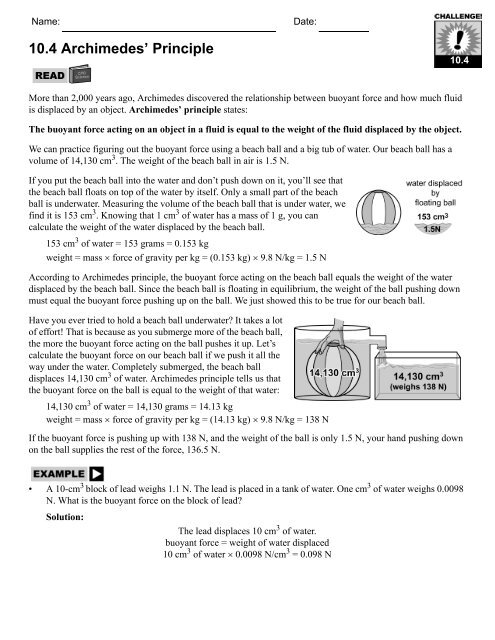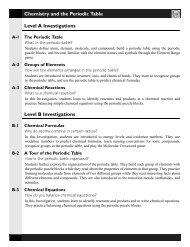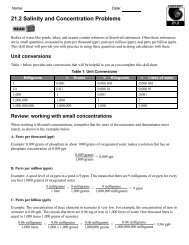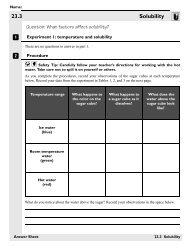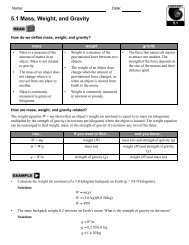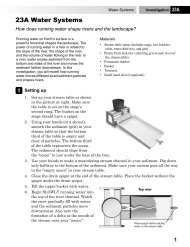PES Skill Sheets.book - CPO Science
PES Skill Sheets.book - CPO Science
PES Skill Sheets.book - CPO Science
- No tags were found...
Create successful ePaper yourself
Turn your PDF publications into a flip-book with our unique Google optimized e-Paper software.
Name:Date:10.4 Archimedes’ Principle10.4More than 2,000 years ago, Archimedes discovered the relationship between buoyant force and how much fluidis displaced by an object. Archimedes’ principle states:The buoyant force acting on an object in a fluid is equal to the weight of the fluid displaced by the object.We can practice figuring out the buoyant force using a beach ball and a big tub of water. Our beach ball has avolume of 14,130 cm 3 . The weight of the beach ball in air is 1.5 N.If you put the beach ball into the water and don’t push down on it, you’ll see thatthe beach ball floats on top of the water by itself. Only a small part of the beachball is underwater. Measuring the volume of the beach ball that is under water, wefind it is 153 cm 3 . Knowing that 1 cm 3 of water has a mass of 1 g, you cancalculate the weight of the water displaced by the beach ball.153 cm 3 of water = 153 grams = 0.153 kgweight = mass × force of gravity per kg = (0.153 kg) × 9.8 N/kg = 1.5 NAccording to Archimedes principle, the buoyant force acting on the beach ball equals the weight of the waterdisplaced by the beach ball. Since the beach ball is floating in equilibrium, the weight of the ball pushing downmust equal the buoyant force pushing up on the ball. We just showed this to be true for our beach ball.Have you ever tried to hold a beach ball underwater? It takes a lotof effort! That is because as you submerge more of the beach ball,the more the buoyant force acting on the ball pushes it up. Let’scalculate the buoyant force on our beach ball if we push it all theway under the water. Completely submerged, the beach balldisplaces 14,130 cm 3 of water. Archimedes principle tells us thatthe buoyant force on the ball is equal to the weight of that water:14,130 cm 3 of water = 14,130 grams = 14.13 kgweight = mass × force of gravity per kg = (14.13 kg) × 9.8 N/kg = 138 NIf the buoyant force is pushing up with 138 N, and the weight of the ball is only 1.5 N, your hand pushing downon the ball supplies the rest of the force, 136.5 N.• A 10-cm 3 block of lead weighs 1.1 N. The lead is placed in a tank of water. One cm 3 of water weighs 0.0098N. What is the buoyant force on the block of lead?Solution:The lead displaces 10 cm 3 of water.buoyant force = weight of water displaced10 cm 3 of water × 0.0098 N/cm 3 = 0.098 N
Page 2 of 21. A block of gold and a block of wood both have the same volume. If they are both submerged inwater, which has the greater buoyant force acting on it?10.42. A 100-cm 3 block of lead that weighs 11 N is carefully submerged in water. One cm 3 of water weighs0.0098 N.a. What volume of water does the lead displace?b. How much does that volume of water weigh?c. What is the buoyant force on the lead?d. Will the lead block sink or float in the water?3. The same 100-cm 3 lead block is carefully submerged in a container of mercury. One cm 3 of mercury weighs0.13 N.a. What volume of mercury is displaced?b. How much does that volume of mercury weigh?c. What is the buoyant force on the lead?d. Will the lead block sink or float in the mercury?4. According to problems 2 and 3, does an object’s density have anything to do with whether or not it will floatin a particular liquid? Justify your answer.5. Based on the table of densities, explain whether the object would float or sink in the following situations:a. A block of solid paraffin (wax) in molasses.b. A bar of gold in mercury.c. A piece of platinum in gasoline.d. A block of paraffin in gasoline.material density (g/ cm 3 )gasoline 0.7gold 19.3lead 11.3mercury 13.6molasses 1.37paraffin 0.87platinum 21.4


